#european removal services
Explore tagged Tumblr posts
Text
Wise Removals Winchester
Website: https://www.wiseremovalswinchester.co.uk/ Address: 26 Colebrook St, Winchester, SO23 9LH Phone: 01962 277102 Business Mail: [email protected] Wise Removals Winchester is a family-owned and operated moving company dedicated to providing exceptional service to residents and businesses in the Winchester area. With over a decade of experience, we have built a reputation for professionalism, efficiency, and customer satisfaction. Our team of highly trained and courteous movers is committed to ensuring a stress-free moving experience for you. We understand that moving can be overwhelming, which is why we go above and beyond to make the process as seamless as possible. From packing and loading to transportation and unloading, we handle every aspect of your move with the utmost care and attention to detail. #Flat Moves #International & European removals #Man and Van Service #Office Removals #Piano Removals #Storage #Student Removals Facebook: https://www.facebook.com/wiseremovalswinchesterUK/ Maps: https://www.google.com/maps?cid=3716627304803101709 Instagram: https://www.instagram.com/wiseremovalswinchester/ Linkedin: http://linkedin.com/in/wise-removals-winchester-85766b314 Twitter: https://x.com/wiseremovalsUK YouTube: https://www.youtube.com/channel/UCgmLiHmsGMgg00bMGMin4pQ






#Flat Moves#International & European removals#Man and Van Service#Office Removals#Piano Removals#Storage#Student Removals
2 notes
·
View notes
Text
Efficiency Redefined: Same Day Courier Services Transforming Deliveries in the UK

In the fast-paced world we live in, the demand for swift and reliable delivery services has never been more crucial. Businesses and individuals alike seek solutions that can bridge the gap between urgency and convenience. The United Kingdom, in particular, has witnessed a surge in the popularity of same day courier services, offering a plethora of options to meet the diverse needs of customers. Let’s delve into the world of expedited deliveries and explore how these services are redefining the logistics landscape.Same Day Courier Service UK
Same Day Delivery Service in the UK:
The advent of Same Day Courier Services in the UK has been a game-changer for those who value time as a critical commodity. Whether it’s a last-minute business document, a vital parcel, or a forgotten item, the same day delivery service ensures that your package reaches its destination promptly and efficiently.
Same Day and Next Day Courier Services in the UK:
Same Day and Next Day Courier Services provide flexibility for businesses and individuals alike. With the option to choose between immediate or next-day delivery, customers can tailor their shipping needs to align with their specific requirements. This flexibility has proven invaluable for industries where time-sensitive deliveries are the norm.
European Same Day Courier:
The reach of these courier services extends beyond the UK, with European Same Day Courier services connecting businesses across borders. This international dimension adds a layer of convenience for companies with global operations, enabling them to meet tight deadlines and maintain a seamless supply chain.
Urgent Courier Service and Emergency Courier:
When urgency is of the essence, services like Urgent Courier and Emergency Courier step in to save the day. Whether it’s a medical delivery, time-sensitive legal documents, or any other critical item, these services prioritize speed and reliability, ensuring that emergencies are addressed promptly.
Next Day Delivery and Bespoke Courier & Relocation Services:
For less time-sensitive deliveries, Next Day Delivery services offer a balance between speed and cost-effectiveness. On the other hand, Bespoke Courier & Relocation Services cater to the unique needs of businesses and individuals who require tailored solutions for house or office removals. These services provide a stress-free experience, handling the logistics of relocation with efficiency and care.
Exhibition & Event Courier and Dedicated Courier Service:
The events and exhibitions industry relies heavily on precision and timing. Exhibition & Event Courier services specialize in transporting materials for events, ensuring that everything arrives on schedule. Dedicated Courier Service takes this commitment a step further, offering exclusive and focused attention to a single client, ensuring their deliveries receive the priority they deserve.
Secure Courier Service and Business Relocation Services:
Security is paramount when it comes to sensitive deliveries. Secure Courier Services employ advanced measures to safeguard valuable or confidential items during transit. Business Relocation Services, on the other hand, cater to the evolving needs of businesses looking to relocate, providing comprehensive solutions to ensure a smooth transition.
In conclusion, the Same Day Courier Services in the UK have become the backbone of modern logistics, offering a diverse range of options to meet the demands of a dynamic market. From urgent deliveries to bespoke relocation services, these couriers are transforming the way businesses and individuals approach their shipping needs. As the logistics landscape continues to evolve, these services are likely to play an even more integral role in ensuring the seamless flow of goods and information across the UK and beyond.
Find out us : 7, Halifax HX1 1DD, United Kingdom
#Same day delivery service in UK#Same Day and Next Day Courier Services UK#Same day delivery in UK#Same Day Courier Service UK#Same Day Courier in UK#Same day Courier Services in UK#European Same Day Courier#Urgent Courier Service#Emergency Courier#Next Day Delivery#House Removal Services#Office Removal Services#Exhibition & Event Courier#Bespoke Courier & Relocation services#Dedicated Courier Service#Secure Courier Service#Business Relocation Services
1 note
·
View note
Note
this might be a silly question, but. ive recently learned more about the devastating effects of sanctions on countries like cuba, dprk, or venezuela, and how much unnecessary suffering they cause among the population, especially when it comes to food or medicine shortages. but then bds also calls for sanctions against israel, and im wondering, is there any meaningful difference between that and the sanctions already imposed by the US on other countries? i feel a bit hypocritical when i argue against sanctions while at the same time supporting bds, i feel like they are very different situations with different outcomes but i lack the understanding to really grasp how they are different, if that makes any sense
Sanctions are the systematic blockade of all or certain sectors of trade under military or economic threat by the sanctioner (mostly just the USA in recent history) to any potential agents who might try to ignore the sanction. These sanctions typically include things like medical supplies, food if the country is dependent on imports (like most countries who get sanctioned), electricity, fuel, both light and heavy industry, agricultural products and machines, the global financial system, and other such key sectors. These sanctions, overwhelmingly, only serve to impoverish the country, create undue suffering and political strife. This political strife/instability is usually the main goal of sanctions, to destabilize the target government. However, this political instability more often than not does not result in a magical restoration of "democracy" or "human rights", it usually leads the country down a path of further isolationism and political violence that only worsens its general situation. It also makes it much easier for factions like ISIS to gain popularity and support, since people are desperate. Sanctions are inhumane measures which only makes a country suffer for no good reason. The sanctioners know this, they don't care, and I'd wager that suffering is often the actual point of these sanctions. What has the 60 year old blockade achieved in Cuba? It has only caused pointless poverty, and the stated goal of the sanctions, which is to ultimately remove the communist government, has failed, is failing, and Cuba is managing to make due with what they have.
BDS call for sanctions mostly in regards to military equipment and related products/services, for NATO to stop aiding the genocide, or the banning of Israel from international events such as the olympics. No Israeli will ever go hungry because they no longer get European-made ordinance or because they don't get to participate in Eurovision. This is what BDS says in their Sanctions and governments campaign (which is behind two menus, this is also not the main focus of BDS, by far):
The BDS movement calls for sanctions against Israel, similar to the sanctions that were imposed against apartheid South Africa. These sanctions could include a military embargo, an end to economic links and the cutting of diplomatic ties. In the meantime, the BDS movement is calling for states to take steps to meet their legal obligations not to be complicit in the commission of particular Israeli crimes and not to provide recognition, aid or assistance that help Israel maintain its regime of settler colonialism, apartheid.. This includes, for example, the obligation for states to immediately end to all trade that sustains illegal Israeli settlements in the Occupied Palestinian Territory and the suspension of free trade agreements and other bilateral agreements with Israel.
Notice the greater emphasis on military and diplomatic ties, and how economic/trade sanctions are only called for when it «sustains illegal Israeli settlements in the Occupied Palestinian Territory». Sure, this will (if it is ever adopted by Israel's significant trade partners) cause some suffering for the poor illegal settlers who had just moved into their shiny new apartment blocks built atop acres of land that sustained the surrounding Palestinian villages. The mere existence of these settlements cause more suffering than any sanction could ever cause.
Calling for these sanctions against Israel, which again, don't even come from comparable agents, are both less harmful towards the total population of Israel, and occur in a completely different context. I'm not going to pretend I care about the wellbeing of settlers whose houses didn't even exist 10 years ago. If these sanctions ever do occur in a significant enough scale (dubious), and those settlers don't want to find themselves in a food desert because Carrefour closed all their stores in the west bank, they shouldn't have moved into land stolen from a people facing genocide in the first place. We're also wagering hypothetical and non-global suffering against the now more than 100,000 dead Palestinians in Gaza in the past year, not even counting those who died ever since the first Nakba.
Like BDS points out, these types of grassroots and targeted boycotts/sanctions worked in South Africa, and the white South Africans didn't even suffer that much. Wager these short-lived and targeted sanctions against these other half-century long sanctions sustained by the US' strongarm policy that have prevented basically anything from getting into Cuba or the DPRK.
While those two things are both called sanctions, they have radically different objectives, methods, range, timescale, and character. I can't reiterate this enough, the North Korean collective farmer and the Israeli settler in the west bank have nothing in common when it comes to their position. Only one of them is complicit in genocide through their own actions, only one of them has any degree of blame, and only one of their governments is actually doing anything that warrants any kind of international action. And again, the BDS strategy focuses much more on military sanctions. Let's also be practical for a second, and acknowledge that the US is never going to withdraw their support for Israel, and especially will never sanction Israel. Israel is simply never going to face the same kind of sanctions that Venezuela or Cuba are facing, nor with the same severity, nor with the same restrictions on products essential for life.
776 notes
·
View notes
Text

The cost of damage to critical infrastructure in Gaza is estimated at around $18.5 billion according to a new report released today by the World Bank and the United Nations, with financial support of the European Union. That is equivalent to 97% of the combined GDP of the West Bank and Gaza in 2022.
The report finds that damage to structures affects every sector of the economy. Housing accounts for 72% of the costs. Public service infrastructure such as water, health and education account for 19%, and damages to commercial and industrial buildings account for 9%. For several sectors, the rate of damage appears to be leveling off as few assets remain intact. An estimated 26 million tons of debris and rubble have been left in the wake of the destruction, an amount that is estimated to take years to remove. The report also looks at the impact on the people of Gaza. More than half the population of Gaza is on the brink of famine and the entire population is experiencing acute food insecurity and malnutrition. Over a million people are without homes and 75% of the population is displaced. Catastrophic cumulative impacts on physical and mental health have hit women, children, the elderly, and persons with disabilities the hardest, with the youngest children anticipated to be facing life-long consequences to their development. With 84% of health facilities damaged or destroyed, and a lack of electricity and water to operate remaining facilities, the population has minimal access to health care, medicine, or life-saving treatments. The water and sanitation system has nearly collapsed, delivering less than 5% of its previous output, with people dependent on limited water rations for survival. The education system has collapsed, with 100% of children out of school. The report also points to the impact on power networks as well as solar generated systems and the almost total power blackout since the first week of the conflict. With 92% of primary roads destroyed or damaged and the communications infrastructure seriously impaired, the delivery of basic humanitarian aid to people has become very difficult.
#yemen#jerusalem#tel aviv#current events#palestine#free palestine#gaza#free gaza#news on gaza#palestine news#news update#war news#war on gaza#gaza genocide#genocide#famine#al shifa hospital#unrwa#children of gaza
563 notes
·
View notes
Text
Canada, Truth & Reconciliation, & Indigenous Games
Hello friends,
Today (September 30th) is the National Day of Truth & Reconciliation in Canada. It is a very recent holiday in this country, and it’s also very important to me. I want to spend some time today telling you about it, and then (since this is a ttrpg blog) directing you to some indigenous storytellers and designers that deserve a spotlight for various reasons.
I am not Indigenous. This information is a collection of knowledge that I have gained through university coursework, personal research I've undertaken, and relationships I've cultivated with indigenous friends who have taken pains to educate me and highlight how these issues have personally affected them. I am aware that the summary I'm providing is incomplete, and there may be elements that I don't fully understand the implications of.
If you are Indigenous, please keep in mind that this post may recall some painful and personal moments of history for you. Proceed with caution. The shout-outs to indigenous creators can be found after the heading “The Storytellers.”
The Truth.
Canada has been engaged in a cultural genocide of its indigenous peoples since European settlers started the colonization of the country. This genocide had many avenues, including the creation of the Indian Act, the relocation of many Indigenous peoples to restricted Reserves, and a disturbing trend of missing and murdered Indigenous women. For the purposes of today however, I’m going to stick to just talking about Residential Schools, and the impact they had on Indigenous families and their children.
Residential schools were designed to “kill the Indian” and “save the child”, in the words of John A Macdonald, the prime minister who authorized their creation. They were designed to sever Indigenous children from their culture and raise them in a Christian, colonial context. These residential schools were harsh, forbidding Indigenous children to speak their mother tongues, cutting their hair, and forcing them to learn skills considered “useful”, in the language of the colonizer, away from their parents. The schools were also hotbeds of abuse. Alarming numbers of children fell ill and died at these schools - the death toll to this day is unknown. From April 1, 1920 to some time in the 1990’s, residential school attendance was mandatory for Indigenous children from the ages of 7 to 16.
The Sixties’ Scoop is a reference to a mass kidnapping of Indigenous children in the 1950’s and 60’s, who were forcibly removed from their homes and “adopted” into non-Indigenous families. While the last residential school in Canada closed in 1997, Indigenous children still make up over 50% of all children in private foster care, despite only accounting for just over 7% of all children under age 15 in Canada.
The Reconciliation.
Reconciliation is a goal prompted by Indigenous groups and elders. It is a choice that promotes "balance and harmony," a way of life that encourages coexistence, according to the words of one residential school survivor, Hereditary Chief, Dr. Robert Joseph.
In 2007, The Indian Residential Schools Settlement came into effect, offering compensation to survivors of many residential schools.
In 2008, the Truth and Reconciliation Commission of Canada was officially launched, intended to be a guide for the Canadian government to help establish lasting reconciliation. This commission was a way to formalize a method of collecting data, and it also had the responsibility of developing a list of recommendations for the country of Canada to follow, in the goal of pursuing a relationship between the Indigenous peoples of Canada and the government of Canada.
In 2007, Cindy Blackstock, a First Nations (Gitxsan) activist launched a court case against the Canadian government, for under-funding social services provided to children living on First Nations reservations. This was in regards to Jordan’s Principle, a child-first Canadian policy that is meant to ensure that First Nations children have equal access to all government funded public services as other Canadian children. The Truth and Reconciliation Commission made the respect of Jordan’s Principle one of its 94 Calls to Action for the Canadian government.
The Canadian Human Rights Tribunal became involved in 2016, when they found more alleged breaches of the Canadian Human Rights Act in regards to Jordan’s Principle. As of September this year, the Federal Government is still attempting to dismiss human rights complaints regarding the use (or, in fact, neglect) of Jordan’s Principle.
Canada’s history of residential schools and use of the foster care system has grievously wounded Indigenous families and children. The disruption of family life and the forcible removal of children from their culture has created legacies of loneliness, pain, and suicide. Indigenous people today can trace their own familial wounds to the legacy of residential schools and the lack of resources provided to them from the government. The National Day of Truth and Reconciliation is a day to remember this legacy and provide a space for education, but it isn’t enough.
You can learn more about this day and the history behind it by visiting the National Centre for Truth and Reconciliation Website.
You can also watch this 18-minute Youtube video about Residential Schools, or We Can’t Make the Same Mistake Twice, a free 2 & 1/2 hour documentary about Blackstock's continuous fight regarding caring for children using Jordan’s Principle.
I also recommend 21 Things You May Not Know About The Indian Act, by Mary-Ellen Kelm and Keith D. Smith, which breaks down some of the key elements of the Indian Act for everyday person.
So, how do we connect this to ttrpgs?
When it comes to the milestones that have been achieved in Canadian history, those milestones have been made because we listened to Indigenous voices. The recommendations made by the Truth and Reconciliation Commission that have been followed are having real and positive effects for Indigenous peoples in Canada. Listening to the stories of Residential School survivors has been integral to the processes recommended and undertaken by the Canadian government.
We need Indigenous stories. We need Indigenous storytellers.
The Storytellers



Coyote & Crow.
Coyote & Crow Games is a tabletop games publisher, primarily focused on the tabletop roleplaying game, Coyote & Crow. This is a world and game whose design team is fully Indigenous, from various First Nations people groups across North America. Coyote & Crow is a futuristic game about a land untouched by colonization, a land changed by a series of climate events that have changed the geographical and social landscape. It involves supernatural powers, a completely unique form of civil organization, and a unique d12 dice pool system
In a recent update, Connor Alexander, as the face of Coyote & Crow, announced some business decisions that include a creation of a consultant branch of the company, to provide professional consultation services for other creative endeavours that are looking to include Indigenous Representation in games.
What I love most about Coyote and Crow is that it’s a world where Indigenous creators have been given full reign over the ways they are represented in the fiction, and it provides a unique social and political imagining of society that pulls from many First Nations cultures. It’s refreshing, it’s exciting, and it provides a lot of guidance for non-Indigenous players so that they can engage with the world in a way that’s respectful.
Wendigo Workshop
This is a small team based in Quebec, Canada. I’m not entirely sure whether the team is fully Indigenous, but there are Indigenous creators as part of the team.
Currently the Workshop is working on a number of different games, including… Anomaly Hunters; a monster hunting ttrpg built on the Breathless SRD. Arkelon Chronicles; a science-fantasy ttrpg surrounding the discovery of an Alien ruin. Last Hope; a Caltrop Core game about magical girls fighting to protect the world while balancing their student lives.
Bramble Wolf Games
@sahonithereadwolf is an Indigenous creator based in Appalachia looking to make games that mean something. I found out about him through his game Exceptionals, a game about community, activism and kinetic eye beams. It’s inspired heavily by X-Men, but instead of telling superhero stories, it’s more about the fostering of a community outside of the systems created and enforced by colonial governments.
Sahoni is also currently working on a game called Protect the Sacred, a game inspired by Indiana Jones, but focused on the protection and preservation of monsters and artifacts in the interests of the cultures that have been stolen from by colonial powers. The game is about your relationship to your culture, and resistance to fascism - and you can get sneak peeks to this game through Sahoni’s Patreon.
Both Protect the Sacred and Exceptionals involve character creation that requires players to answer questions about who they are, what they do, and how they affect the community around them. They both recognize the community around you as integral to your success, and I think that this point of view is such an important concept to consider when using games as an art form that can expand your social imagination.
Also...
There is a consultancy service in Alberta, Canada called Pe Matawe Consulting, which is not focused specifically on ttrpgs, but does provide consulting for various creative endeavours. They provide consulting services as well as workshops, with the goal of providing a broader understanding of Indigenous culture and folklore.
162 notes
·
View notes
Text

Today on the second advent and door no. 8 we have a lovely pair, La Grace and Shtandart

More about them here:
La Grace is a replica of a historic tall ship from the 18th century that will sail the seven seas like the original ship 300 years ago. The aim of the project is to give anyone interested the opportunity to sail a historic ship as part of the Navy's training programme and to share the proud traditions of sailing.
The brig was built between 2008 and 2010 by a group of volunteers from the Czech Republic and Slovakia in an Egyptian shipyard in Suez using traditional craft techniques. The brig was designed by its owners (Josef Dvorsky and Daniel Rosecky) according to technical drawings published in 1768 in the Architectura navalis mercatoria by the Swedish admiral Fredrik Henrik af Chapman.
According to available sources, the original La Grace was a ship owned by the first Czech naval captain Augustin Herrman, a famous navigator in Czech history. He sailed across the Atlantic in the service of the Dutch West India Company. After leaving the company, he commanded the small privateer ship La Grace. This relatively weak and vulnerable ship with six cannons brought large quantities of captured Spanish galleons to New Amsterdam every year.
The Shtandart is a replica of an 18th century frigate. The original was the first frigate built at the Olonez shipyard under Peter the Great and the first ship to be commissioned as a frigate for the Baltic Fleet. During the Great Northern War, Tsar Peter succeeded in conquering the area that would later become St Petersburg on the Neva. With the conquest of the fortress of Nöteborg in 1702, Lake Ladoga was removed from Swedish control and the Tsar hoped to gain access to Finland. The aim of these endeavours was to gain access to the Baltic Sea in order to establish a port city there for trade and naval purposes.
The frigate was built from 1702 at the Olonez shipyard on the Lodejner Feld on the River Swir near Lake Ladoga, where it was given its name in reference to the newly introduced Russian naval flag, a standard. Tsar Peter personally transferred the ship to the Baltic Sea in 1703. When seven Swedish ships of the line, five frigates and other small ships attacked the mouth of the Neva in June 1705, eight Russian frigates, presumably including the Schandart, lay behind a barrage of trees. In 1712 and 1713, she took part in troop landings in Swedish Finland near Vyborg. No further use is mentioned after this action. The ship was decommissioned as unserviceable in 1718. In 1723, the ship was scrapped in St. Petersburg.
According to another version, Tsar Peter had ordered the Schandart to be preserved as a reminder of the beginnings of the Russian fleet. Tsarina Catherine I ordered the condition of the Petrine ships to be examined in 1727. However, the Shtandart broke up while trying to take her out of the water.
As a result of the sanctions against Russia following the Russian invasion of Ukraine in 2022, Russian ships are denied access to European ports. However, following a request from the Président des Amis des Grands Voiliers association to the French Secretary of State, the Shtandart was granted permission to call at French and Spanish ports and has remained there ever since. There are plans to put her under the French flag, as her captain strongly distances themselves from Russia.
#naval history#tall ships#brig la grace#frigate shtandart#18th century#replicas#age of sail#advent calendar#day 8
108 notes
·
View notes
Text
here's the thing, though, that CONSTANTLY drives me up the wall
the reason why Victorians Thought The Way They Did about Sex and A Woman's Place has its roots in economics, specifically, the effect the Industrial Revolution had on women's economic labor, and as such WAS A PRODUCT OF ITS PLACE AND TIME and cannot be extrapolated backwards, or sideways onto other cultures
prior to the Industrial Revolution, there were, essentially, two functioning economies (caveat that everything I'm going to say applies to Europe and European-descended cultures and I in no way am meaning these to be universal statements): the male economy and the female economy. Men's economic work was primarily conducted outside the home and was more often exchanged for currency; women's economic work was primarily conducted inside the home and was more often exchanged for goods and services, but it was nevertheless economic work that was, most of the time, absolutely vital to the survival of the household (for a good example of the early modern American female economic world, see: A Midwife's Tale, the Life of Martha Ballard, by Laurel Thatcher Ulrich)
it was also, in large part, based on things like textile production that were very quickly mechanized during the Industrial Revolution. thereby removing women from participation in the economy (at least if you were rich enough to stay out of the factories).
with minimal economic activity left, there needed to be a new role for (wealthier) women, and the Victorian ideal of "the moral center of the home" was born. add that to what has been referred to as the "desperate insecurity of empire" and you have a new era of sexual repression that really, really did not exist before
women's independence has always been tied to women's economic power, that is, the relative value of "women's work" in society (for another example, see the discussion of Egyptian women's independence related to their Greek counterparts in the Classical era as related to the relative value of textile production between the two societies, in Women's Work: the First 2,000 Years by Elizabeth Wayland Barber)
so any depiction of "historically accurate" misogyny has to first answer the question of a) what part of history; b) what economic activity are women engaged in; c) has there been mechanization of textile production yet?; d) no?; e) then stop giving them fucking Victorian values for fuck's sake
220 notes
·
View notes
Note
Carlos fans trying to say Carlos experience racism and xenophobia are literally insane…… He is a white Spaniard, that’s why sometimes I can’t stand f1 fans honestly
Not to continue my "fandom on twitter is batshit" hate campaign but this is COMPLETELY a twitter fandom type of problem and becuase it's specifically such a twitter fandom type trait it so clearly marks who is an F1 fan and who is just into F1 because it's the 'thing to be into' and 'content to consume' after the DSMP collapse or one's favourite kpop idol having to do military service....
But it remains batshit. As someone who did the entire DSMP experience on twitter I can speak from experience when I say that fandom on there is this writhing mass of angry echo chambers that are so far removed from reality it's staggering. I would be willing to bet my savings that NONE of these accounts have said a single word about the way Yuki is treated by his team or the literal incident at border security the other day–you know–ACTUAL racism and xenophobia.
Also all Europeans hate all other Europeans. It's in our nature. Every European country has derogatory terms for every other European country because of wars fought centuries ago. It's part of our charm. "Maybe try asking him in Spanish" is hilarious actually, and one I'm definitely going to steal for casual ribbing.
#this turned into an anti twitter post but my god i hate fandom on that site#tumblr tends to be a lot better because we don't really have trends and conversation topics move a lot slower#and followings don't really matter!#I Love Tumblr. Actually#asks#anon
54 notes
·
View notes
Text


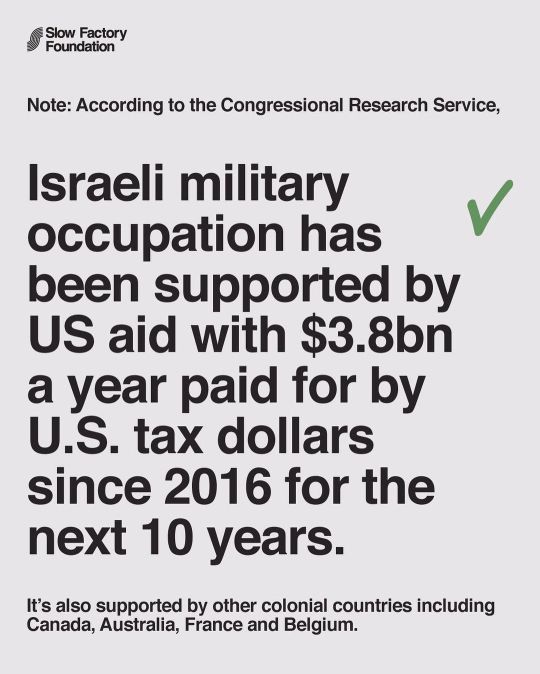
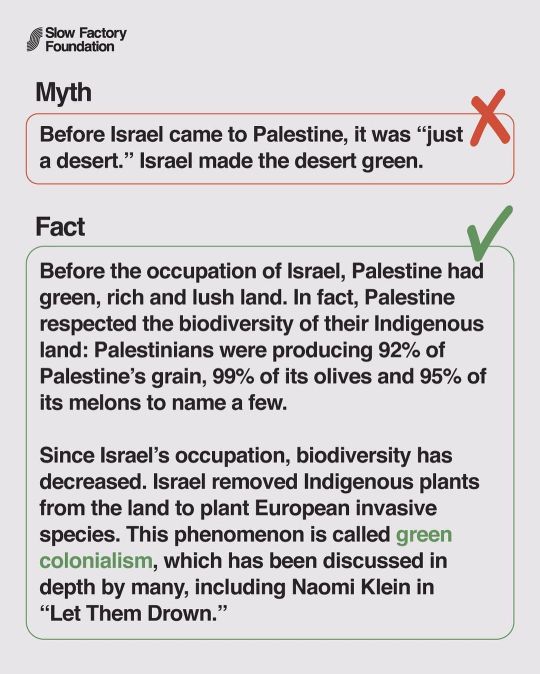
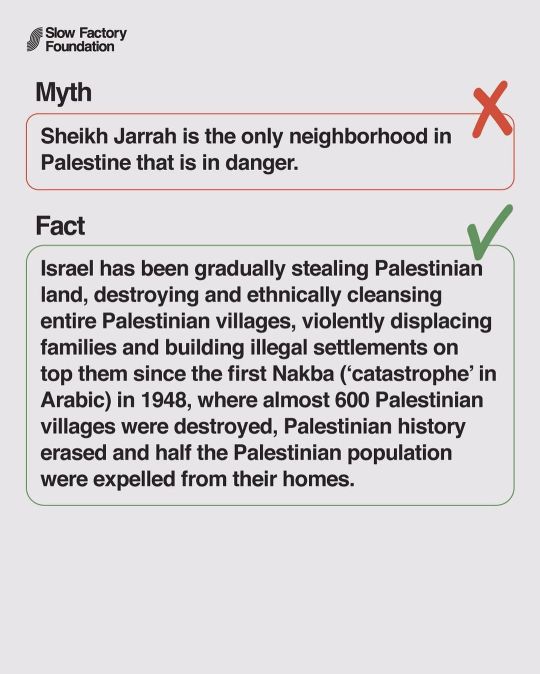
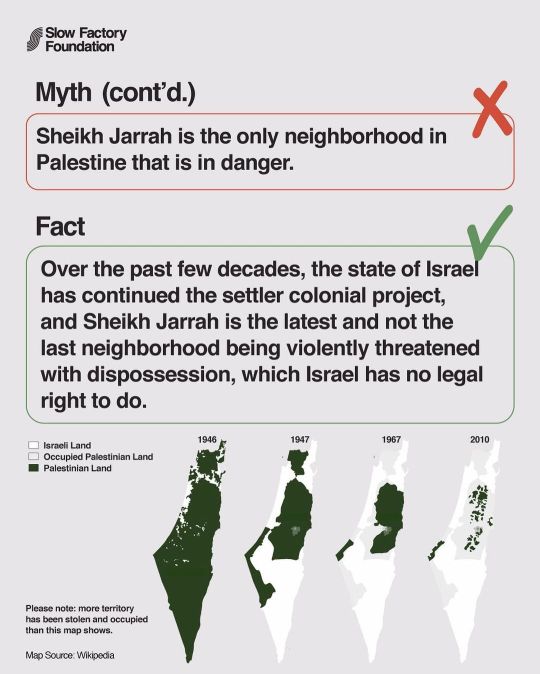
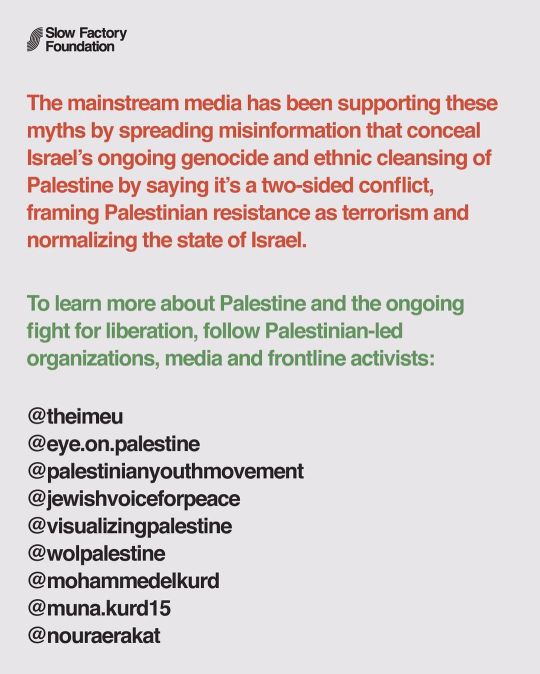
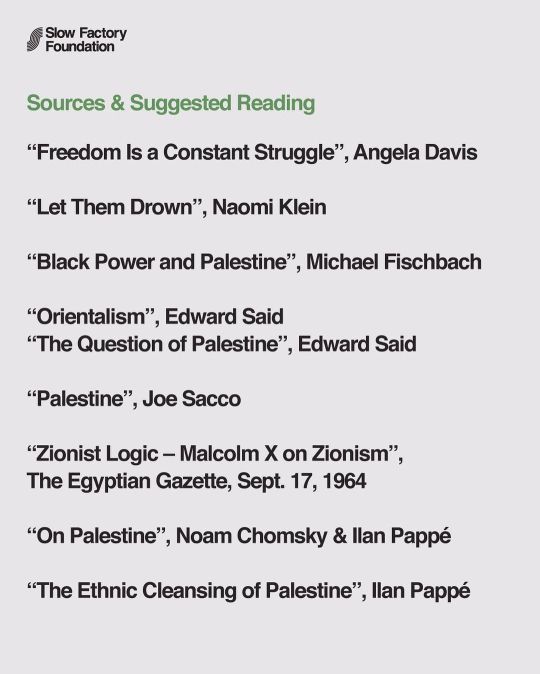
[This post is a series of images from an infographic by the Slow Factory Foundation originally posted May 2021. The first image is a photo with text over it. The photo shows a massive fireball in the middle of a group of buildings, with a massive black cloud rising from the flames that is bigger than the buildings themselves. The building just behind the fireball is low, rectangular, and lit up bright orange. Behind that building, there is a city lit up at night. Hundreds of buildings stretching into the distance, a thousand glimmering lights.]
What is happening in Palestine is not complicated; it's settler colonialism & ethnic cleansing.
Debunking Misinformation around Palestine.
Myth ❌ Palestine and Israel are in "conflict."
Fact ✅ What is happening in Palestine is settler colonialism, military occupation, land theft and ethnic cleansing. A conflict means there is equal footing, which is not the case. There is an active oppressor (Israel) and an oppressed (Palestine). A colonizer (Israel) and a colonized (Palestine). This is not a conflict.
[Three images of headlines with the word 'conflict' crossed out in red ink.]
Note: According to the Congressional Research Service,
Israeli military occupation has been supported by US aid with $3.8bn a year paid for by U.S. tax dollars since 2016 for the next 10 years.
It's also supported by other colonial countries including Canada, Australia, France and Belgium.
Myth ❌ Before Israel came to Palestine, it was "just a desert" and Israel made the desert green.
Fact ✅ Before the occupation of Israel, Palestine had green, rich and lush land. In fact, Palestine respected the biodiversity of their Indigenous land: Palestinians were producing 92% of Palestine's grain, 99% of its olives and 95% of its melons to name a few.
Since Israel's occupation, biodiversity has decreased. Israel removed Indigenous plants from the land to plant European Invasive species. This phenomenon is called green colonialism, which has been discussed in depth by many, including Naomi Klein in "Let Them Drown."
Myth ❌ Sheikh Jarrah is the only neighborhood in Palestine that is in danger.
Fact ✅ Israel has been gradually stealing Palestinian land, destroying and ethnically cleansing entire Palestinian villages, violently displacing families and building illegal settlements on top them since the first Nakba ('catastrophe' in Arabic) in 1948, where almost 600 Palestinian villages were destroyed, Palestinian history erased and half the Palestinian population were expelled from their homes.
Myth (cont'd.) ❌ Sheikh Jarrah is the only neighborhood in Palestine that is in danger.
Fact ✅ Over the past few decades, the state of Israel has continued the settler colonial project, and Sheikh Jarrah is the latest and not the last neighborhood being violently threatened with dispossession, which Israel has no legal right to do.
[Images of a map showing the drastic decrease in Palestinian landmass from 1946 to 2019. In 1946, Palestine was 99% Palestinian land. In 1947, it decreased to 40%. In 1967, to 30%. And in 2019, less than 20% of Palestine is Palestinian land. The remaining areas are being encroached on by occupied Palestinian land, meaning occupied by Israelis. The rest is Israeli land.]
The mainstream media has been supporting these myths by spreading misinformation that conceal Israel's ongoing genocide and ethnic cleansing of Palestine by saying it's a two-sided conflict, framing Palestinian resistance as terrorism and normalizing the state of Israel.
To learn more about Palestine and the ongoing fight for liberation, follow Palestinian-led organizations, media and frontline activists. [@Instagram / Facebook]
@theimeu / Institute for Middle East Understanding ( IMEU )
@eye.on.palestine
@palestinianyouthmovement / Palestinian Youth Movement (PYM)- حركة الشباب الفلسطيني
@jewishvoiceforpeace / Jewish Voice for Peace
@visualizing_palestine / Visualizing Palestine
@wolpalestine [Censored by Meta]
@mohammedelkurd / Mohammed El-Kurd
@muna.elkurd15 / Muna Nabeel Elkurd
@nouraerakat / Noura Erakat
Sources & Suggested Reading
Freedom is a Constant Struggle by Angela Davis
Let Them Drown by Naomi Klein
Black Power and Palestine by Michael Fischbach
Orientalism by Edward Said
The Question of Palestine by Edward Said
Palestine by Joe Sacco
"Zionist Logic — Malcolm X on Zionism" in The Egyptian Gazette, Sept. 17, 1964
On Palestine by Noam Chomsky and Ilan Pappé
The Ethnic Cleansing of Palestine by Ilan Pappé
[End of images]
#the slow factory#palestine#gaza#angela davis#naomi klein#michael fischbach#edward said#joe sacco#malcolm x#noam chomsky#ilan pappé#Noura Erakat#Muna Nabeel Elkurd#Mohammed El-Kurd#Eye On Palestine#IMEU#Palestinian Youth Movement#Jewish Voice for peace#Visualizing Palestine
275 notes
·
View notes
Text

Thank you for letting me know, I will be responding with a censored screenshot so I can protect their privacy while I address this.
I have a post where I detail my policy when it comes to minors interacting with my content, so if you want my full opinion you can read it here. That being said, there is a certain threshold where age becomes more problematic.
After consulting Tumblr's Terms of Service, it seems that the minimum age to use the platform for most regions outside of the European Union is 13. It implies, however, that mature content would be made unavailable for younger users, assuming - of course - that they were honest about their age.
I will look into the possibility of flagging the account for review, so that it can be provided with more safeguards and privacy. I personally don't believe in blocking, because it doesn't solve the core issue, and it removes the access to a trusted adult. So, we shall see how this approach turns out.
Now, just in case there's other kiddos reading this post and wiping their foreheads, let me give you a little reminder. Please go through this article and keep it as a mental check list.
94 notes
·
View notes
Text
While Russia has made a slew of outlandish assertions about Ukraine, including that the country is led by a Nazi regime, few Russian narratives have entrenched themselves more thoroughly in the Western far right and far left than that Ukrainian President Viktor Yanukovych was illegitimately removed from office in a Western-backed coup in February 2014. This claim has been a key element of Russian propaganda, echoed in the United States by such public figures as independent U.S. presidential candidate Robert F. Kennedy, Jr., filmmaker Oliver Stone, and Cato Institute defense expert Ted Galen Carpenter.
The idea that Yanukovych’s removal was illegitimate is easily refuted: After Yanukovych abandoned his office by fleeing from Ukraine to Russia, he was stripped of the presidency by a constitutional majority in parliament. Even Russia joined the rest of the world in recognizing the new Ukrainian government a few months later.
But the truth underlying the events of February 2014 is far more interesting: The preponderance of evidence suggests that it was Moscow itself that triggered Yanukovych’s departure in order to launch a pre-arranged Plan B—the invasion of Crimea and an engineered “uprising” in eastern Ukraine—after Moscow’s Plan A—a new treaty with a pliant government in Kyiv that placed it under Russia’s de facto control—was about to fail. Indeed, the timeline shows that preparations for Plan B were well underway before Yanukovych’s removal from office. All this, in turn, demonstrates that Russian President Vladimir Putin’s plans for Ukraine were far more predatory all along than merely preventing the country’s drift toward NATO, as many of Russia’s Western apologists contend.
The Maidan mass protests—which lasted from November 2013 to February 2014 in Kyiv and many other cities across Ukraine—erupted when Yanukovych pivoted from a wide-ranging association agreement with the European Union to a similar one with the Russian-led Eurasian Economic Union. Ukraine’s move toward closer relations with the EU was the trigger for Putin’s Plan A: the transfer of Ukraine to the Kremlin’s sphere of influence. To stop Yanukovych’s deal with Europe, Moscow pressured Kyiv with trade sanctions, including an embargo of key Ukrainian exports to Russia. In return for joining Russia’s economic bloc, Moscow offered Kyiv an emergency $3 billion loan to shore up a budget drained of resources by Yanukovych’s corruption. At the same time, Russia pressured him to violently crush the Maidan, suppress the pro-Western opposition, and thereby alienate him from the West. Toward this end, officials from the Russian security services and Putin aide Vladislav Surkov were frequent visitors in Kyiv.
Yanukovych, who had never established an absolute autocracy on the Russian model, resisted an all-out crackdown against the hundreds of thousands of largely peaceful protesters throughout western and central Ukraine. As his final actions as president would show, he also retained the hope of being able to balance Russian influence with continued relations with the West. It was to prevent that outcome that Moscow triggered his departure.
In all, more than 100 civilians and 13 police and security service operatives would die during the Maidan. Yet while the security services brutally attacked protesters all throughout the Maidan, the main deadly violence only occurred between Feb. 18 and Feb. 20, 2014—precisely the time when negotiations between the government and opposition over a political compromise were gaining traction. Brokered by the foreign ministers of Poland, France, and Germany—Radoslaw Sikorski, Laurent Fabius, and Frank-Walter Steinmeier, respectively—with Putin envoy Vladimir Lukin present as well, negotiations had begun to gain momentum on Feb. 17. Over the next three days, 78 protesters and 11 police were killed.
This level of violence shocked and angered Ukrainian society. In response to mounting public fury and the threat of extensive Western sanctions, Yanukovych intensified negotiations on a compromise and moved to release detained and imprisoned protesters. For Putin, however, any path of negotiated compromise was a clear setback to his Plan A, which would have locked Yanukovych and his government into complete dependency on Moscow.
As deadly violence engulfed the streets of Kyiv, Yanukovych signaled his agreement to a broad government of national unity. After the opposition turned down the top post of prime minister, Yanukovych indicated that he would nominate Serhiy Tihipko, the billionaire former head of Ukraine’s central bank. For the Russians, Tihipko was a red flag: He had denounced politicians who were willing to “sacrifice Ukraine’s territorial integrity for electoral votes,” was a proponent of Ukraine’s integration with the EU, and opposed making Russian the second state language.
Coupled with the potential transfer of key ministries into the hands of the opposition and new elections by year’s end, Yanukovych’s willingness to compromise set off alarm bells in the Kremlin, whose representative, Lukin, withheld his signature from the agreement. Once before, during the 2004 Orange Revolution, Yanukovych had disappointed Putin by refusing to use brute force to stay in power after falsified presidential elections. When Yanukovych eventually returned to power by legal means in 2010, he further angered Russia with negotiations toward a free trade agreement with the EU, which he only aborted after extensive Russian economic sanctions and embargoes on Ukrainian exports. To Putin, Yanukovych was again vacillating and refusing to show an iron hand.
On the morning of Feb. 20, after two days of violence had failed to crush the Maidan and with Yanukovych on the verge of signing a compromise agreement with the opposition, the Kremlin pivoted. A delegation of Russian Federal Security Service officials, including Sergei Beseda, head of the Fifth Service in charge of international operations, arrived in Kyiv—the third such visit since the Maidan began. Officially there to “protect Russian diplomatic facilities,” Beseda’s real mission was to advise hardliners inside Yanukovych’s leadership team, block a compromise, and, failing that, set in motion a Plan B—Russia’s ambitious plot to splinter Ukraine.
As the EU envoys met with Yanukovych and opposition leaders to finalize the deal—and as Yanukovych did not agree to a request by Beseda to meet—the hardliners in the government escalated, presumably under Moscow’s instructions. Then-Ukrainian Interior Minister Vitaliy Zakharchenko and Security Service chief Oleksandr Yakimenko unleashed a brutal attack on the protesters in an apparent attempt to unravel the deal that that was in the process of being struck.
Indeed, Feb. 20 proved to be the bloodiest day, with police snipers shooting 48 protesters.
Zakharchenko’s role in the mayhem is well established, as are his close relations with Russia’s security services, who advised him tactics and had equipped his ministry with grenades, tear gas, and other crowd control munitions purchased for $100,000. His role as a trusted Russian asset was confirmed after his escape to Moscow, when he became senior advisor to Rostec, Russia’s state company in charge of sensitive advanced technologies, including for the military. He also ran a Russian fund that rewarded traitors from Ukraine’s security forces. Yakimenko, who had spent a decade as an officer in Russia’s armed forces and whose murky past suggested links to Russian security services, deployed snipers from the Ukrainian Security Service’s Alpha special forces unit. Ukrainian prosecutors would later allege that Yakimenko subsequently supplied pro-Russian insurgents in Ukraine with weapons as part of Putin’s effort to dismember Ukraine.
In the aftermath of the mass killings, Yanukovych signed the Agreement on the Stabilization of the Political Crisis in Ukraine on Feb. 21. But the bloodshed had changed the political calculus. Denounced by the opposition and abandoned by many of his allies in parliament, calls for Yanukovych to step down gained momentum. Yet even for the most radical elements in Ukraine’s opposition, there was no way to force him out, especially with the continued presence of thousands of militia and security forces that remained under the command of officials closely aligned with Russia. Hundreds of armed pro-Yanukovych vigilantes had also arrived from the Donbas.
Yet surprisingly, as the compromise was being ratified, this massive security infrastructure suddenly vanished. The Berkut riot police and the Alpha group exited the government quarter, where most of the protests were taking place, along with hundreds of other police. Sikorski described the sudden and systematic withdrawal as “astonishing,” noting it was not part of the agreement. This dramatic U-turn could not have happened in such rapid and orderly fashion had it occurred through internal divisions in the security services—the usual last and necessary step in the collapse of a regime. Nor were there any prior signs of security service defections to the opposition in Kyiv. The sudden stand-down can only be explained as a top-down decision by Russia’s fifth column in the security services leadership. The justification for abandoning Yanukovych overnight was soon afterward intimated by Putin: On March 4, 2014, he said that by compromising with the opposition, “Yanukovych had in fact surrendered all his power.”
Absent the Kremlin’s support, amid the disappearance of Yanukovych’s security services in the government quarter, and with a majority for a new coalition emerging in parliament, the isolated Yanukovych sought desperately to maintain his leverage and relevance. Hoping, perhaps, to maintain some semblance of power, he switched to Russia’s Plan B—the splintering of Ukraine. He traveled to Kharkiv later that day to lead a conference of regional government leaders from southern and eastern Ukraine, but was rebuffed by leaders from his own Party of Regions. Rather than attending an ineffectual rump conference, Yanukovych escaped on the night of Feb. 21 to Crimea, where Russia’s takeover of the peninsula was already underway.
It was in only in the aftermath of Yanukovych’s flight from Kyiv and disappearance from Kharkiv that Ukraine’s Rada met on Feb. 22, and by a constitutional majority stripped him of office. On Feb. 28, Yanukovych finally resurfaced in Rostov-on-Don, Russia, where he gave a press conference denouncing his removal from office. It was to be his last major public event. He then disappeared from the media and Russian propaganda, which soon switched to trumpeting the “Russian Spring”—the supposed uprising in Ukraine’s south and east, largely orchestrated by Russian assets. Plan B was now in full effect.
In the end, Russia’s efforts failed in Odesa, Kharkiv, Kherson, and Mykolaiv. But it succeeded in much of the Donbas and led to Russia’s rapid annexation of Crimea. On March 26, 2014, the Russian Defense Ministry celebrated the annexation of Crimea by minting a medal. The medal, which initially appeared on a Defense Ministry website but was later removed, bears the date of the start of the “return of Crimea”: Feb. 20, 2014. It is highly unlikely that this dating of the launch of Russia’s operation to dismember Ukraine—two full days before the supposed “coup” that removed Yanukovych—is a mistake.
The Maidan mass protests and civic action were a landmark event in Ukraine’s history. The Maidan, without question, blocked Putin’s Plan A—Ukraine’s march, as a whole, into Russia’s orbit. The Maidan also forced Yanukovych to agree to new elections, compelled him to appoint a caretaker coalition government, and helped Ukraine’s democratic institutions endure. But it is no less true that it was precisely for this reason that, as an agreement was about to be struck in the final days of the Maidan, Russia rapidly shifted to its prepared Plan B, withdrew support from Yanukovych, and launched its operation to partition Ukraine.
A clear understanding of Putin’s actions and motives during this critical period in Ukraine’s history is not just a matter of setting the record straight. It is crucial in understanding Putin’s longstanding aims, which went far beyond blocking Ukraine’s accession to NATO or the EU. By early 2014, his ultimate aim was already the dismemberment of Ukraine and the eventual incorporation of many of its territories into Russia. Putin never abandoned his grandiose revisionist aims, which resurfaced in the large-scale invasion Russia launched on Feb. 22, 2022, eight years to the day that Yanukovych was removed from office.
72 notes
·
View notes
Photo

Christmas was one of the highlights of the medieval calendar, not only for the rich but also for the peasantry. For the longest holiday of the year, typically the full twelve days of Christmas, people stopped work, homes were decorated and a Yule log burned in the hearth. Gifts were exchanged, colourful church services enjoyed and merry feasts were eaten by all where there was better food and more of it than at any other time in the year. There were plenty of songs, dancing, pantomimes and games, too. For many, just as today, Christmas was the best of times. The European medieval calendar was not short of holidays: each season had its own special Christian celebration, often based on older pagan traditions. Medieval holidays were a chance to have a much-needed rest from the usual daily toil and to socialise at family meals where the typical dreary menu of the poor was replaced by such rarities as meat and fish and the table of the rich was adorned with exotica like roast peacock. Christmas was the longest holiday of the year by far and lasted from the night of Christmas Eve, the 24th of December, to the Twelfth Day, the 5th of January. Mid-winter was a time of year which saw a lull in agricultural activity and consequently many peasants were permitted by their lord to have the entire two weeks off. The season also involved gift-giving and decorating the home with garlands and wreaths of winter foliage. As one description of 12th-century CE London by William Fitzstephen records: Every man's house, as also their parish churches, was decked with holly, ivy, bay and whatsoever the season of the year afforded to be green. (quoted in Gies, 100) Holly, with its glossy dark green leaves and bright red berries, has been considered the ideal winter decoration since antiquity. Ancient Celtic druids thought it sacred and able to ward off evil spirits while the Romans used it as a gift to show esteem and goodwill. Mistletoe is another long-used decoration which ancient people thought a bringer of fertility, protector of crops and something that kept away witches. Long before the Christmas tree took centre stage in the 19th century CE, a double ring of mistletoe was the centrepiece of many a home's decorations, under which couples could kiss, removing the jewel-like berries with each peck.
25 notes
·
View notes
Text
‘Refusing to actively assist in a genocide’ is the absolute lowest of low bars, an existentially minimal expectation of a post-war European polity. But that’s where we are. The ranks are closed and serried. It is a hypnotically grotesque spectacle. Meanwhile, in Gaza, the killing intensifies. Genocide has still been on the table all this time, it seems. Every piety about it being the ultimate evil was just so much noise, to be discarded when it became awkward. It now appears that thinking genocide is bad is for the little people. Or perhaps it is a ‘luxury belief’. The most powerful states in the world have enshrined remembrance of the Holocaust in their public places, their calendars, their museums, their education systems. We were given to understand that this was because genocide was the final, absolute line: never, ever again, for anyone. But insofar as Britain and other nations have ignored or assisted Israel’s campaign in Gaza, it turns out that these same states have in fact kept systematic human extermination and ethnic cleansing on the list of possible political options, as rights which they might need to exercise one day. At my most grimly cynical, I fear that this is because the Northern states have concluded that the coming age will take the form prophesied by the Bannonites and neo-reactionaries—a time of sovereign power amidst climate breakdown—and this means they want leeway to operate as they will, at home and abroad, without being bound by any laws or responsibilities, moral or otherwise. Gaza is the end of all pretence to a belief in any law but that of raw force, and as such, it is the proving ground for all tomorrow’s hells.
[...]
The British state is an active and official participant in an ongoing genocide, its politicians and press are running cover, its intelligence services and military are actively involved. The fact that this is still barely in the papers, and that the people who have taken to the streets asking for it to stop have been denounced as hate-filled racists and fanatics, should tell you all you need to know about how much anyone in power or in the press ever really understood or cared about ‘never again’. Perhaps I am naïve, but the purpose of Holocaust education, as I always understood it, was not to teach us that we should obediently wait and see what position pundits and politicians would take on urgent events, and then follow their lead. Nor was it so we could take the long view, see both sides, mutter about complexities, patiently wait for years to pass and for evidence to be gathered. No, the purpose of the quite extensive Holocaust education that most people in this country received was surely so we would know a genocide when we saw it. We were supposed to learn what it looked like so it could be stopped, and so that our perpetual duty to those who died in the camps – a duty consisting of an eternal never again, the magnetic north of personal and political morality – would be rightly discharged, should our time ever come to discharge it. It was so we would not be the ones who turned a blind eye to the removal of our friends and colleagues; so that we would know to speak, to act, to refuse to let it happen without a fight; so that we would never betray a hiding child, never denounce a neighbour, never find ourselves just following orders. Whatever else could it possibly have been for, if it was not to know these things, yourself, in your heart? What can the story of Anne Frank mean to us, as individuals, if it does not mean that we must each of us internalise the lesson that we should never give up a child to genocidaires? And did we not learn, too, that the state would bombard us with propaganda, that the truth would be hidden, and that without effort we would become inured and complacent so that it would not be so simple to see what was before us, and so that many would simply accept what was happening without demur? Were we not warned? We were. A clearly distressed Palestinian man whose mother and family had been killed in the bombardment of northern Gaza was recently manhandled out of a Labour party event in Stockport for the transgression of asking people to look at photographs of his dead mother. In a widely circulated film, Labour deputy leader Angela Rayner stands frozen and silent as he is violently ejected. What has happened to those heart lessons she was supposed to learn? Is this not the very moment for which those lessons were prepared, the moment that we were warned about? If not now, when?
108 notes
·
View notes
Text
The women of Iran are dancing. Women blinded, with one eye, or one arm, are dancing. Iranian Kurds are dancing. Across Europe, Iranian dissidents are dancing. Iranians – often, relatives of the regime’s victims – are drinking to show their joy. The daughters of Minoo Majidi, a mother shot dead by security services during the 2022 protests, shared a video of them raising a glass to President Raisi’s death.
Dark humour – the jokes of an oppressed people – are circulating. “Mr Raisi, you surprised us. We have no tapas for our drinks,” chuckles one Iranian in a celebratory video on social media. There was the gag about how a Mossad agent called “Eli Copter” had caused the crash. People have handed out cakes and sweets in public squares – an act of symbolic importance in Persian culture, often associated with joyous events. Celebratory fireworks filled the skies in Iranian cities.
Such courage is all the more impressive given how little Raisi’s death is likely to change anything in this closed prison of a society. It may somewhat alter the succession, since he had been one of the men tipped to succeed Khamenei, but the Ayatollahs retain their stranglehold. The bravery of anyone involved in any celebration or act of civil disobedience such as removing a headscarf, is astounding. Those letting off fireworks or handing out sweets are risking their lives.
History will remember Raisi as a squalid tyrant who took a twisted pride in human suffering. He was involved in the torture and extrajudicial murder of thousands of political prisoners held in Iranian jails and the mass killings of opponents in 1988, when as many as 30,000 are believed to have lost their lives. As Mariam Memarsadeghi wrote in a chilling article for Tablet magazine, “virgins were systematically raped before their execution, to circumvent the Islamic prohibition on killing virgins and to prevent women and girls from reaching heaven”.
And yet, the BBC posted about “President Ebrahim Raisi’s mixed legacy in Iran”. You can imagine the 1945 headlines about the mixed legacy of “motorway-builder, vegetarian rights enthusiast and dog-lover” Adolf Hitler, or that of “inspirational plus-size influencer” Hermann Goering. Reuters described how Raisi “rose through Iran’s theocracy from hardline prosecutor to uncompromising president, as he burnished his credentials to position himself to become the next supreme leader”.
Reading such things you would think Raisi was, at worst, a slight renegade. A cheeky chappie in a kaftan whose loss will be felt by light entertainment for generations. They tweeted like he was Rod Hull – rather than, you know, someone nicknamed “the Butcher of Tehran”. But in the real world, faced with the real consequences of the regime he ran, people are dancing.
It wasn’t just the BBC in its classic “tightrope walk” mode, either. Things were getting a bit Candle in the Wind at the UN, as the entire Security Council (including both the UK and US representatives) stood to observe a minute of silence for President Raisi. Goodbye Tehran’s rose.
European Council president Charles Michel tweeted out his sincere condolences, while the “European Commissioner for Crisis Management” committed the EU’s Copernicus satellite system to help locate Raisi’s helicopter, in the name of “#EUSolidarity”.
Lest we forget, Johan Floderus, a young EU official from Sweden, has been incarcerated at Iran’s notorious Evin prison for more than two years. We don’t see much “#EUSolidarity” coming from the other direction. Not to be undone, President Higgins of Ireland channelled the spirit of Eamon de Valera c.1945, by offering his “deepest sympathies” upon the death of a tyrant.
Such statements go well beyond basic diplomacy. Nobody asked anyone to gush; they chose to. The message it sends is a slap in the face to those bravely putting their lives on the line for freedom. But it’s par for the course in what is (sometimes optimistically) termed the “international community”.
Speaking of which, on Monday, the International Criminal Court put out joint bids for arrest warrants for the leaders of Hamas and the prime minister and defence minister of Israel. Given that the ICC has no jurisdiction, nor power of its own to arrest anyone, there was something bleakly comic about the manner of the announcement. Chief prosecutor Karim Khan delivered his statement flanked by a couple of glaring bureaucrats. The ICC appeared to be putting on its best “don’t mess with us” face. It looked like a geriatric version of Bugsy Malone.
The ICC application refers, pointedly, to the “territory of Israel” and the “state of Palestine”, which makes it clear which side its bread is buttered. It notably ignores Hamas’s use of human shields, surely a factor when assessing the civilian death toll. It even holds Israel entirely responsible for “closing the three border crossing points” after October 7.
Yet Hamas destroyed the Erez crossing, murdering its operators and blowing up the barriers separating it from the Gaza strip. Small wonder border checkpoints weren’t up and running immediately. Condemning Israel for this is grotesque; gaslighting on an international scale.
The timing is also telling. We have known about the crimes of October 7 from day one, thanks to the body-cams Hamas terrorists so proudly wore to document their butchery. Yet the ICC waited until May 2024 to condemn both Israel and Hamas on the same day. The effect is to suggest a moral equivalence between a democratic state and a genocidal terrorist group that says it wants to repeat the atrocities of October 7 indefinitely. You don’t have to believe Israel is above criticism – and nor should we – to recognise this.
Multinational organisations like the ICC are often held up as moral arbiters in themselves, when they will only be as virtuous or corrupt as their component member states, and reflecting the same biases. The World Health Organisation has long excluded Taiwan from its membership due to Chinese pressure. A ruinous decision, when Taiwan’s early warnings about the risks of human-to-human transmission of Covid in late 2019 were ignored. Something is rotten in the state of many international bodies and moral courage is in short supply.
Given such a clear-cut case of evil as Raisi, the mealy-mouthed global response does not bode well. For genuine bravery, we can look to the people at the sharp end of such regimes. Because still, in the midst of it all, the women of Iran dance.
86 notes
·
View notes
Text
Best WLW News Stories of 2023

Meet South Korea’s first lesbian couple to have a child
#hong kong#ohio#baldur's gate 3#andorra#church of england#nepal#latvia#estonia#pope francis#lesbian#gay#lgbt#lgbtq#wlw#bi#girls who like girls#lgbtqia#sapphic#news#2023#new year#south korea#Christmas
124 notes
·
View notes
Text
Dean Obeidallah at The Dean's Report:
I read Timothy Snyder’s, “On Tyranny: Twenty Lessons from the Twentieth Century.” I also re-read portions the compelling book, “How Democracies Die.” Add to that I took in chunks of two books about the Gilded Age (1870’s to 1900) where the arrogance and corruption of America’s wealthy elite led to The Progressive Era backlash of laws and reforms that reined in their power. (I’ll be writing much more in the future on the types of reforms needed now to end the new “Gilded Age” we live in headed by oligarch Elon Musk and the other modern day “robber barons.”) [...]
To wake up those who may be lulled into that sense that Trump wasn’t being literal, Snyder gave a chilling example. Just three days after Hitler became Chancellor of Germany on January 30, 1933, a leading newspaper for German Jews published an editorial that sought to alleviate concerns of the Jewish population.
As you read the excerpt below keep in mind it was written before any of the anti-Jewish laws in Germany had been enacted and well before Jews in Germany had been arrested and sent to death camps: “We do not subscribe to the view that Mr. Hitler and his friends, now finally in possession of the power they have so long desired, will implement the proposals circulating in [Nazi newspapers]; they will not suddenly deprive German Jews of their constitutional rights, nor enclose them in ghettos, nor subject them to the jealous and murderous impulses of the mob. They cannot do this because a number of crucial factors hold powers in check … and they clearly do not want to go down that road. When one acts as a European power, the whole atmosphere tends towards ethical reflection upon one’s better self and away from revisiting one’s earlier oppositional posture.”
This publication was not intending to gaslight the Jews of Germany. They had heard Hitler and his allies advocate everything listed above. Yet the editors and others like them sincerely didn’t believe Hitler meant what he said and that his “better self” would restrain him. But just four months after Hitler took power in Jan. 1933, he began to implement every single policy that he had vowed to do during the prior years. It all began in April 1933 with the passage of a new civil service law that removed Jews from civil service positions, including schools, universities, and government jobs. Next came laws barring Jews from public schools and working in newspapers--all building to the “Nuremberg Race Laws” in 1935 where “Jews lost their citizenship and became subjects of the state.” [...]
Let me end any delusions you may hold deep down. Trump—like Hitler did—will attempt to enact as policy every single thing he has vowed to do during the campaign. And while Trump in his first term was dangerous, this version of Trump is even more dangerous. He is angry and bitter. Trump believes he was wronged by Democrats who sought to hold him accountable for his crimes. He and his followers even believe Democrats were behind the attempts on his life. And in his second term, Trump knowns--courtesy of the corrupt GOP Supreme Court—that he has broad immunity for “official actions.” [...] Trump has repeatedly vowed to shutdown media outlets that he views as being unfair to him—from CBS to NBC News. He will attempt to do that as well as shutdown comedy shows that mock him--as he explored doing to “Saturday Night Live” in his first term. And the list goes on from prosecuting Barack Obama, New York AG Tish James, Adam Schiff and others to mass deportations which he vowed would be “bloody.” Everything Trump promised to do, he will try.
Dean Obeidallah wrote a solid column in his Substack on why Americans should take Donald Trump’s words and actions seriously, as he seeks to implement fascist policies that erode the Constitution and civil society.
All proper-thinking folk should resist this turn towards fascism with all of our might, including blue state defiance and secession if necessary.
#World History#American History#Nazi Germany#Nazis#United States#Donald Trump#Trump Administration II#Trump Administration
20 notes
·
View notes